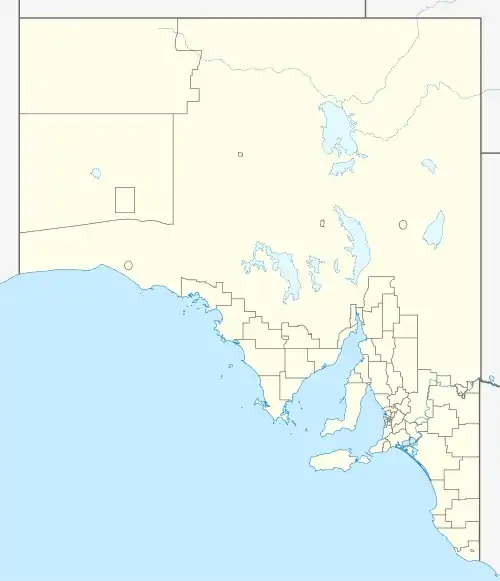| Brookfield Conservation Park South Australia | |
|---|---|
 Brookfield Conservation Park | |
| Nearest town or city | Blanchetown |
| Coordinates | 34°21′22″S 139°29′24″E / 34.35611°S 139.49°E |
| Established | 6 July 1978 |
| Managing authorities | Department for Environment and Water |
| See also | Protected areas of South Australia |
Brookfield Conservation Park is a conservation park located in South Australia, about 130 km northeast of Adelaide.
History
The area that became Brookfield Conservation Park was first settled in 1836 as a pastoral lease.[1] Pioneer farming families kept sheep, which were confined in brush yards overnight and protected by shepherds living in simple slab huts.[1] The area was later named Glen Leslie Station; during this period, the station grazed up to 2000 sheep and eucalyptus mallees on the land were razed for wood and charcoal.[1] In 1971, using a $55,000 donation from the Forest Park Foundation of Peoria, the Chicago Zoological Society purchased the land as a conservation reserve for the southern-hairy nosed wombat (Lasiorhinus latifrons).[1][2] The station was renamed Brookfield Zoo Wombat Reserve, after Brookfield Zoo in Chicago, Illinois.[1][2][3] Six years later, the land was gifted to the Government of South Australia.[1][2] Brookfield Conservation Park was formally proclaimed on 6 July 1978, under the National Parks and Wildlife Act 1972.[1][3] Beginning in 2008, the park is now managed in partnership with Conservation Volunteers Australia.[3]
Wildlife
Brookfield Conservation Park comprises three main habitat types: open mallee Eucalyptus; arid woodland including sugarwood (Myoporum platycarpum) and dryland tea-tree (Melaleuca lanceolata); and arid shrubland including bluebush (Maireana spp).[3] The park is home to an important population of southern hairy-nosed wombats.[3] Other mammal species include fat-tailed dunnarts, common dunnarts, red kangaroos, and western grey kangaroos.[3] The park's birdlife includes two species of fairywren, the splendid fairywren and purple-backed fairywren.[4] Other notable birds include emus, ground cuckoo-shrikes, Australian owlet-nightjars and malleefowl.[3]
Gallery
 Dirt road running through the park.
Dirt road running through the park. Accommodation for researchers.
Accommodation for researchers. Derelict charcoal pit along the Charcoal Pits Walk.
Derelict charcoal pit along the Charcoal Pits Walk. A southern hairy-nosed wombat.
A southern hairy-nosed wombat. Two galahs.
Two galahs.
References
- 1 2 3 4 5 6 7 National Parks and Wildlife Service South Australia. "Brookfield Conservation Park". www.parks.sa.gov.au. Archived from the original on 2023-03-03. Retrieved 2023-03-04.
- 1 2 3 Uphues, Bob (2020-01-07). "Bush fires spare park named in honor of Brookfield Zoo". Riverside Brookfield Landmark. Archived from the original on 2023-03-03. Retrieved 2023-03-03.
- 1 2 3 4 5 6 7 Curtis, Tricia; Davies, Joanne (2012). "Brookfield - a new approach to the management of public land". In Figgis, Penelope; Fitzsimons, James; Irving, Jason (eds.). Innovation for 21st Century Conservation. Australian Committee for IUCN Inc. pp. 192–199.
- ↑ "Birds from different species recognize each other and cooperate". EurekAlert!. 2018-05-21. Archived from the original on 2023-03-03. Retrieved 2023-03-03.